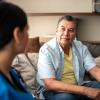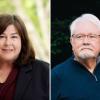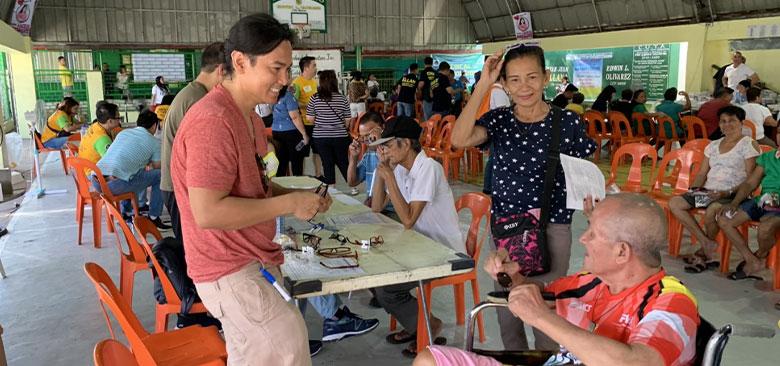
UCSF Nursing PhD candidate Ariel Baria has visited the Philippines six consecutive years, providing volunteer care. (Photo courtesy of Ariel Baria).
Nursing Students Give Back
In their commitment to serve the underserved, students at the UC San Francisco School of Nursing apply the skills they’ve learned to help marginalized communities.
They administer flu vaccines at local public libraries, churches and farms; volunteer at homeless shelters; provide health counseling at children’s wellness camps in California and elsewhere in the nation; deliver critically needed health care in rural parts of California, and more.
Some are also finding ways to give back beyond their local communities. Here are the stories of a few of our UCSF nursing students making a difference in the lives of those who need help abroad.
Coming Home Again, and Again, and Again…
Ariel Baria is reminded he’s one of the lucky ones each time he returns to the Philippines.
“I have relatives there who were not as fortunate as I was to come to the U.S., and get a great education, and be given the opportunities I have been given,” said Baria, a PhD candidate in the School of Nursing.
That gratitude and a love for his homeland are why Baria returns annually to provide free medical care.
Most recently in April, Baria visited the Philippines for the sixth consecutive year with Global Health Force. The nonprofit group and its volunteers – which include physicians, nurses, 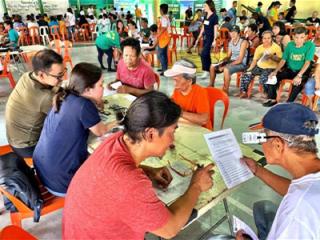 Baria providing an optical assessment to a patient in Danao, Philippines. nurse practitioners and pharmacists – cared for about 1,700 people in a single week. They typically spend two days in Manila and two days in a rural area where the need is greater, treating ailments like urinary tract infections and chronic diseases such as diabetes and hypertension. Minor surgeries are also performed.
Baria providing an optical assessment to a patient in Danao, Philippines. nurse practitioners and pharmacists – cared for about 1,700 people in a single week. They typically spend two days in Manila and two days in a rural area where the need is greater, treating ailments like urinary tract infections and chronic diseases such as diabetes and hypertension. Minor surgeries are also performed.
The patients – many from poor, rural areas with little to no running water – often have the agonizing choice of purchasing food or medicine, Baria said. That Baria and his colleagues can provide a three- to four-month supply of ibuprofen, vitamins and medications is vital.
Baria estimates he treats about 50 to 70 patients daily. One year, he recalled, there were only four volunteers, and he treated about 100 patients per day.
“The days are long, but it doesn’t feel like work,” Baria said. “Knowing that you’re giving them something keeps us going.”
Born in Manila and raised in San Francisco, Baria wanted to become a nurse since high school. He was influenced by his aunt, also a nurse, and the significant number of Filipinos who enter the profession.
After investing 20 years in clinical nursing, including stints at UCLA Health and the VA Greater Los Angeles Healthcare System, Baria found himself wanting to give more, so he turned his focus to research and UCSF.
“The faculty here is great, and I’m able to build on my clinical knowledge,” Baria said. “It’s a bit scary, but it’s worthwhile to pursue this journey.”
Baria’s motivation also stems from the fact that Filipino males with PhDs in nursing are uncommon.
“I want to show people I can do this,” he said. “If people see that you can do it, it’s easier for them to try. That’s important for our profession.”
Learning “Cultural Humility”
Students Carolina Jimenez, Jordyn Smith and Helen Walker could have enrolled in any number of local or online classes to learn Medical Spanish. Instead, they wanted an immersive experience with a clinical element.
They found it at Pop Wuj, one of the few free clinics in Quetzaltenango, Guatemala, where they spent one month this past summer.
The ability to speak Medical Spanish is increasingly important, especially in California where 39 percent of the population – about 15.5 million people – is Latinx, according to the 2018 U.S. Census.
Pop Wuj offers both a classroom setting to learn Medical Spanish and patient interaction, allowing students to consult alongside local physicians and nurses.
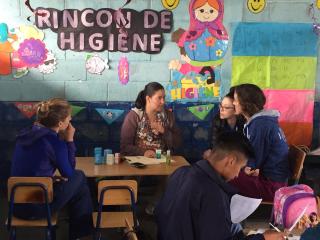 From left, Helen Walker, Carolina Jimenez and Jordyn Smith worked closely with Guatemalan health care professionals while studying Medical Spanish at Pop Wuj. (Photo courtesy of Jordyn Smith). Pop Wuj serves those who cannot afford private clinics and specialists. Smith said patients can be seen for about a $3 co-payment, and prescriptions are free. Much of the clinic’s funding comes from visiting students, who pay $300 per week. Those funds go toward salaries for the clinic’s staff and Spanish teachers, and the students’ host families.
From left, Helen Walker, Carolina Jimenez and Jordyn Smith worked closely with Guatemalan health care professionals while studying Medical Spanish at Pop Wuj. (Photo courtesy of Jordyn Smith). Pop Wuj serves those who cannot afford private clinics and specialists. Smith said patients can be seen for about a $3 co-payment, and prescriptions are free. Much of the clinic’s funding comes from visiting students, who pay $300 per week. Those funds go toward salaries for the clinic’s staff and Spanish teachers, and the students’ host families.
An important dynamic of the program for Smith was the “cultural humility” it taught visiting students.
“It wasn’t one of those programs where Americans were going to come in and change the status quo,” Smith said. “It was rather we’re going to come in and learn from the Guatemalan doctors and nurses about how things are done here. For me, that was really important because I didn’t want to go somewhere where I felt like I was intruding on someone’s community and trying to impose ideas that aren’t appropriate for their culture.”
The program is beneficial for both Spanish speakers and non-Spanish speakers. Despite being a native Spanish speaker, Jimenez encountered some unfamiliar language.
"As a future healthcare provider, I want to work with underserved, Spanish-speaking populations, so it was important for me to spend the summer learning medical Spanish terminology,” Jimenez said. “The clinical component of the program allowed me to apply and reinforce the terminology I learned in the classroom.”
The students, who began in the School's Master's Entry Program in Nursing, also spent time in the community. They visited a local school to teach children proper oral care and built stoves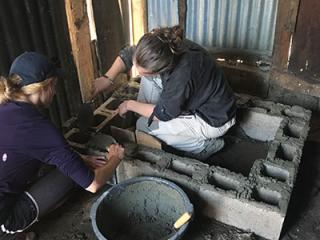 Volunteers building a stove for families in Guatemala. (Photo courtesy of Jordyn Smith). for families. Smith said most families in the rural areas outside Quetzaltenango cook indoors over an open fire, allowing harmful fumes to spread throughout their homes. Walker said the new stoves direct smoke out of the homes, and saves families money by using less firewood – an added environmental benefit.
Volunteers building a stove for families in Guatemala. (Photo courtesy of Jordyn Smith). for families. Smith said most families in the rural areas outside Quetzaltenango cook indoors over an open fire, allowing harmful fumes to spread throughout their homes. Walker said the new stoves direct smoke out of the homes, and saves families money by using less firewood – an added environmental benefit.
“The respiratory health of the people in these communities is pretty poor,” Smith said. “Putting in the stoves changes so much for the families not only on safety, but having more options for food and drink throughout the day. Also, it is a more empowering position for the women to stand.
“The awesome part is you’re going to these families’ homes and building the stove. There’s no middleman to worry about. Your hands are in it, and that’s special.”
Making Deliveries Safer in Kenya
Morgan Aurelio was introduced to nurse midwifery in high school when her biology teacher brought in photos of a former student practicing the specialty.
Those images proved powerful and life-altering.
“One of the things I like most about nurse midwifery is the opportunity to be in a really vulnerable place with people,” Aurelio said. “In that vulnerability, there’s so much honesty and trust. I saw that in those pictures, and I’d never really seen anything like that before.”
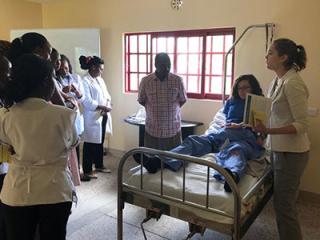 DNP candidate Morgan Aurelio addresses hospital staff before beginning an obstetric simulation (Photo courtesy of Morgan Aurelio). Those photographs planted the seed for a career in nurse midwifery, and Aurelio is realizing that vision half a world away. An experienced nurse midwife and candidate in the School of Nursing’s Doctor of Nursing Practice (DNP) program, Aurelio is conducting quality improvement research on and implementation of obstetric teaching simulations in Kenya.
DNP candidate Morgan Aurelio addresses hospital staff before beginning an obstetric simulation (Photo courtesy of Morgan Aurelio). Those photographs planted the seed for a career in nurse midwifery, and Aurelio is realizing that vision half a world away. An experienced nurse midwife and candidate in the School of Nursing’s Doctor of Nursing Practice (DNP) program, Aurelio is conducting quality improvement research on and implementation of obstetric teaching simulations in Kenya.
In Kenya, there are 31 infant deaths per 1,000 live births, according to the United Nations IGME Child Mortality Report— about five times higher than the United States (six per 1,000) and 15 times higher than Japan (two per 1,000).
Aurelio says the combination of high patient volume and low staffing and resources are main causes.
“I think what’s happening is you have staff filling roles and tasks that they have often not had specialty training in, due to necessity —I sometimes see newer nurses conducting vaginal births alone because of high patient to provider ratios ,” Aurelio said. “The hospital and staff are doing the best they can with what they have, but these are certainly challenging circumstances.”
Aurelio’s alma mater, the University of Washington, has a partnership with a public, rural hospital in Kenya. Leveraging that connection, she consulted with the hospital’s lead midwife and lead OBGYN about their greatest needs, and proposed to conduct obstetric emergency simulations as her DNP project.
About eight to 10 hospital personnel – two physicians and a combination of nurses and midwives – participate. Aurelio utilizes the PRONTO method, developed by UCSF professor Dilys Walker, which specializes in simulation and team training in low-resource environments.
For instance, in a simulation, an actress wears special medical scrub pants that hold an artificial baby and artificial placenta. The actress pushes the baby through the scrubs, mimicking 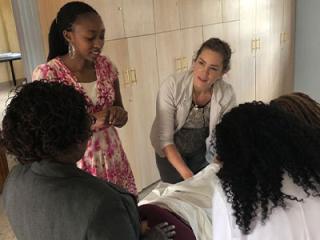 Aurelio utilizes the PRONTO method, developed by UCSF professor Dilys Walker, which is designed specifically for obstetrics teams in low-resource environments. (Photo courtesy of Morgan Aurelio). childbirth. The scrubs contain a small bag of red liquid that the actress can open to simulate hemorrhaging. The worsening situation of the simulated childbirth challenges the staff’s communication skills and teaching the importance of interprofessional collaboration.
Aurelio utilizes the PRONTO method, developed by UCSF professor Dilys Walker, which is designed specifically for obstetrics teams in low-resource environments. (Photo courtesy of Morgan Aurelio). childbirth. The scrubs contain a small bag of red liquid that the actress can open to simulate hemorrhaging. The worsening situation of the simulated childbirth challenges the staff’s communication skills and teaching the importance of interprofessional collaboration.
“People are short-staffed and in situations where they’re not necessarily comfortable yet to deal with the emergency at hand,” said Aurelio, “but if they have the tools of communication and mutual support, and if that is normalized during these emergency trainings, the site would be more successful and have better outcomes.”
Aurelio is on track to complete the DNP program in December, and is open to teaching and continuing her clinical work. Whatever Aurelio decides, she wants to feel the emotions from those midwifery pictures a decade ago.
“I was amazed by that,” she said, “and that’s exactly what midwifery continues to be for me.”

